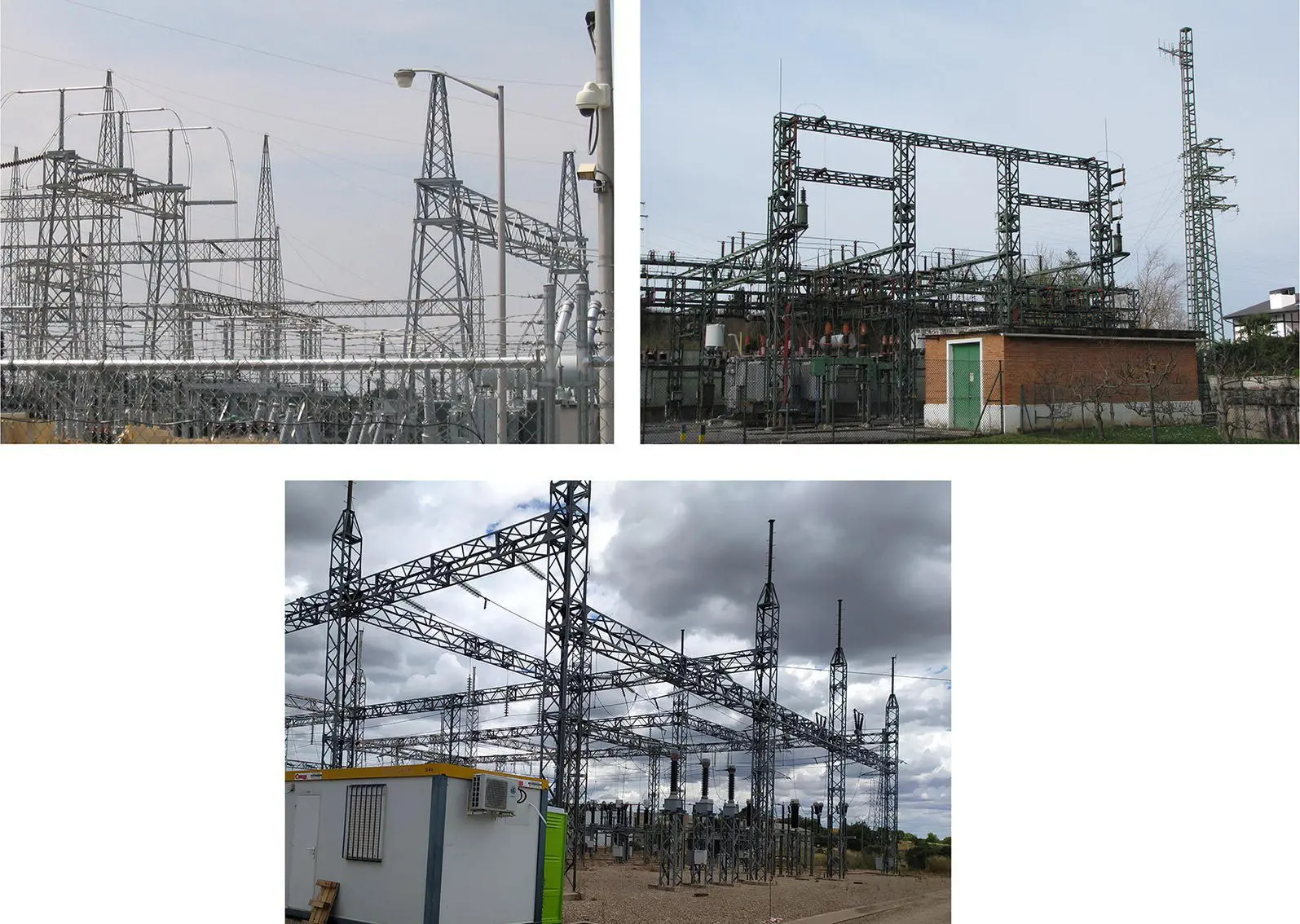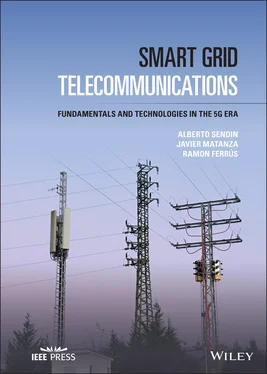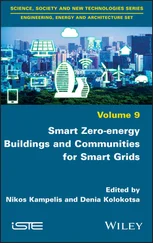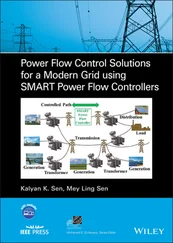Ramon Ferrús - Smart Grid Telecommunications
Здесь есть возможность читать онлайн «Ramon Ferrús - Smart Grid Telecommunications» — ознакомительный отрывок электронной книги совершенно бесплатно, а после прочтения отрывка купить полную версию. В некоторых случаях можно слушать аудио, скачать через торрент в формате fb2 и присутствует краткое содержание. Жанр: unrecognised, на английском языке. Описание произведения, (предисловие) а так же отзывы посетителей доступны на портале библиотеки ЛибКат.
- Название:Smart Grid Telecommunications
- Автор:
- Жанр:
- Год:неизвестен
- ISBN:нет данных
- Рейтинг книги:3 / 5. Голосов: 1
-
Избранное:Добавить в избранное
- Отзывы:
-
Ваша оценка:
- 60
- 1
- 2
- 3
- 4
- 5
Smart Grid Telecommunications: краткое содержание, описание и аннотация
Предлагаем к чтению аннотацию, описание, краткое содержание или предисловие (зависит от того, что написал сам автор книги «Smart Grid Telecommunications»). Если вы не нашли необходимую информацию о книге — напишите в комментариях, мы постараемся отыскать её.
Discover the foundations and main applications of telecommunications to smart grids Smart Grid Telecommunications,
Smart Grid Telecommunications
Smart Grid Telecommunications — читать онлайн ознакомительный отрывок
Ниже представлен текст книги, разбитый по страницам. Система сохранения места последней прочитанной страницы, позволяет с удобством читать онлайн бесплатно книгу «Smart Grid Telecommunications», без необходимости каждый раз заново искать на чём Вы остановились. Поставьте закладку, и сможете в любой момент перейти на страницу, на которой закончили чтение.
Интервал:
Закладка:
Producing the power needed in the system is the task for the Generation segment in a traditional electric power system. In traditional monopolistic environments, vertically integrated utilities knew when, where, and how much electricity was going to be needed and scheduling of energy production was relatively easy. More recent market‐based decentralized approaches have increased the complexity of the task for the sake of the system efficiency. Short‐term markets (bidding mechanisms) and bilateral agreements between producers and consumers need to be coordinated. Eventually, energy producers offer their production capacity and get it awarded in, with a price assigned per MW to the different generation sources.
Technical aspects of the different conventional generation sources are taken into consideration together with the economic mechanisms. Their different constraints (e.g., costs, speed of startup and shutdown, capacity factor, forecast of day availability) determine unit commitments [11]. These are assignments of a production rate and temporal slot some time in advance of the real need. To cope with unexpected contingencies, the reserves (i.e., the “back‐up” generation units) are planned as well.
Frequency stability is a key aspect of power system operation. It starts in the Generation segment. Traditional production of electricity (hydro, fuel, nuclear) involves mechanical elements (e.g., water, steam, or gas flowing through a turbine) and has an effect on the rotational speed of the turbine that consequently determines the exact frequency of the electricity signal. If rotational speed is higher, frequency is higher too. Loads also affect system frequency: when load is heavy, the turbine will tend to rotate more slowly, and the output frequency will be lower. This effect needs to be compensated on the generator side (with the mechanical resources) to keep the frequency as close as possible to the 50 or 60 Hz nominal value.
Voltage levels are the other key aspect that needs to be controlled. Loads in the system exhibit a reactive behavior and, if the consumption of reactive power is excessive, the generated output power will not be efficiently used. The grid (Transmission and Distribution segments) takes care of compensating loads to keep reactive consumption low and maximizes the real power flowing in the system. As a last resource, generators may need to act.
Transmission systems support the electricity transported in the power line. These systems need to be highly reliable, resilient, and able to dynamically adapt to physical limitations and tolerances of the cables (e.g., thermal) to minimize system losses. Control of the reactive part of the load is done with Volt‐Ampere Reactive (VAR) regulation elements (inductors, capacitors, and semiconductor switches) deployed in the grid; other losses are highly dependent on weather conditions (humidity and temperature). Geomagnetical‐induced currents must also be taken into account [12], as they might cause damage specially in long conductors (more common in North America than in Europe). Transmission is highly coordinated with Generation, as network capacity expansion must be coordinated with any new generation plant in the grid, and the hubs it must reach depend on where the electricity is needed.
Distribution systems are the most significant in terms of territory coverage and have a fundamental role in supply availability and quality control. Distribution operations take care of the control and the voltage regulation (i.e., LV levels within limits in both the unloaded and full‐load conditions), power factor (i.e., the reactive part of the load), harmonics (degradation of the waveform frequency, more common due to the growing presence of solid‐state switching devices in the grid), and voltage unbalance among phases in multiphase systems. Literature [4] specifically identifies concepts such as supply outages (supply interruptions of different duration), voltage drops (dips in supply voltage), overvoltage (voltage increases caused by network events), voltage wave harmonics (deviations from the fundamental frequency), and flicker (low‐frequency fluctuations in voltage amplitude frequency).
1.2.4 The Grid Assets
Grid assets are the elements of the electric power system. This section will focus on the network part of it, i.e., Transmission and Distribution segments.
All the network elements are important not only because they are the elements making the grid work but also because they are the elements to be controlled, the ones needing telecommunication services, and the ones that can be used to support the means to develop telecommunication networks (e.g., optical fiber cables on the power lines).
1.2.4.1 Substations
Substations are the grid nodes where voltage level is transformed. PSs transform voltage from HV to MV and SSs from MV to LV. Both PSs and SSs use transformers for this purpose, and as voltage is reduced, current is increased. Voltage transformation takes place in several stages and at several substations in sequence. These substations are connected through power lines.
Other than the transformer as the main component of a substation, substations consist of a complex set of circuit breaking, and control equipment arranged to direct the flow of electric power. Substations perform several functions, namely, safety (isolating parts of the system in case an electric fault occurs), operation (minimization of energy losses; separation of parts of the network when maintenance or network upgrades are needed), and interconnection (if different electric networks with diverse voltages need to be connected).
PSs ( Figure 1.5) are designed for several specific functions such as regulating voltage to compensate for system changes, switching transmission and distribution circuits, providing lightning protection, measuring power quality and other parameters, hosting communication, protection, and control devices, controlling reactive power, providing automatic disconnection of circuits experiencing faults, etc. They contain elements such as line termination structures, switchgear, transformer(s), elements for surge protection and grounding, capacitors and voltage regulators, and electronic systems for protection, control, metering, etc. These elements are usually connected to each other through conductor buses or cables within the facility. PSs are quite homogeneous in its design and external appearance. Most of them are big outside compounds where power lines and metallic structures can be easily identified.

Figure 1.5 Primary substation examples.
SSs ( Figure 1.6) are located at the edge of MV networks, close to end‐users, where electricity is transformed to LV for Consumption Points. LV grids are deployed to reach the customers, and therefore, SSs are located close to the end‐users. In Europe, SSs normally supply an LV area corresponding to a radius of some hundred meters around the SS; North and Central American Distribution networks consist of an MV network from which numerous (small) MV/LV transformers supply one or several consumers, by direct service cable (or line) from the SS transformer location (thus SSs may be just a number of small transformers on top of a pole).
The number of SSs in the grid exceeds the number of PSs with a factor than can be in excess of 100. Due to their relevance in the evolution into the Smart Grid, it is worth describing the structure of an SS, from its MV input to its LV output:
MV lines. These are the power lines carrying voltages and currents that originate from PSs.
Switchgear or MV panels. These are the interfaces between MV lines and the transformer or transformers. The switchgear protects the transformer and allows the interconnection of MV feeders. Switchgear maybe open‐air or encapsulated air‐insulated (old versions) or encapsulated with a gaseous dielectric medium (usually sulfur hexafluoride, SF6).
Читать дальшеИнтервал:
Закладка:
Похожие книги на «Smart Grid Telecommunications»
Представляем Вашему вниманию похожие книги на «Smart Grid Telecommunications» списком для выбора. Мы отобрали схожую по названию и смыслу литературу в надежде предоставить читателям больше вариантов отыскать новые, интересные, ещё непрочитанные произведения.
Обсуждение, отзывы о книге «Smart Grid Telecommunications» и просто собственные мнения читателей. Оставьте ваши комментарии, напишите, что Вы думаете о произведении, его смысле или главных героях. Укажите что конкретно понравилось, а что нет, и почему Вы так считаете.












